Managing Quality In Health And Social Care: Doc
VerifiedAdded on 2021/01/01
|15
|5139
|370
AI Summary
Contribute Materials
Your contribution can guide someone’s learning journey. Share your
documents today.
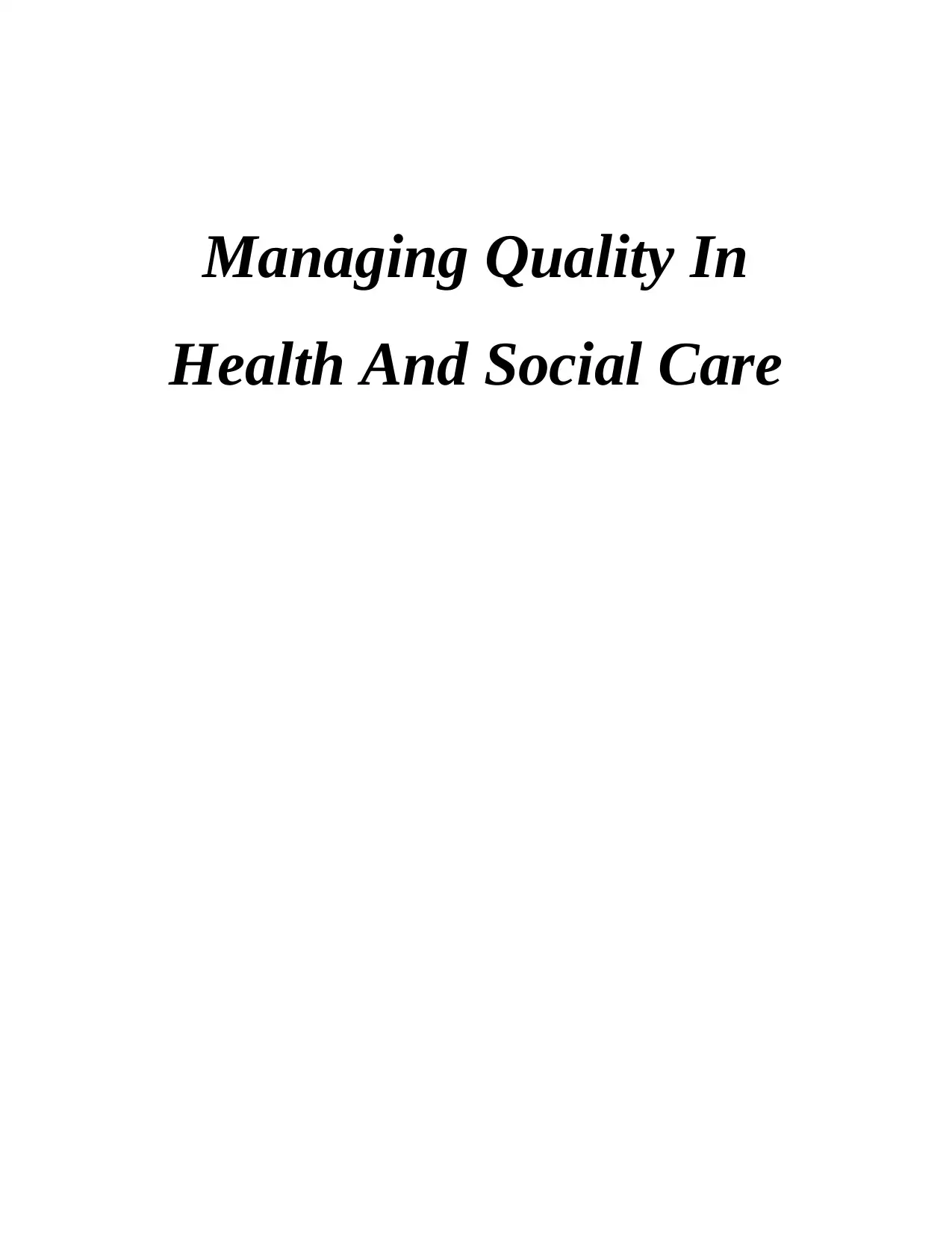
Managing Quality In
Health And Social Care
Health And Social Care
Secure Best Marks with AI Grader
Need help grading? Try our AI Grader for instant feedback on your assignments.
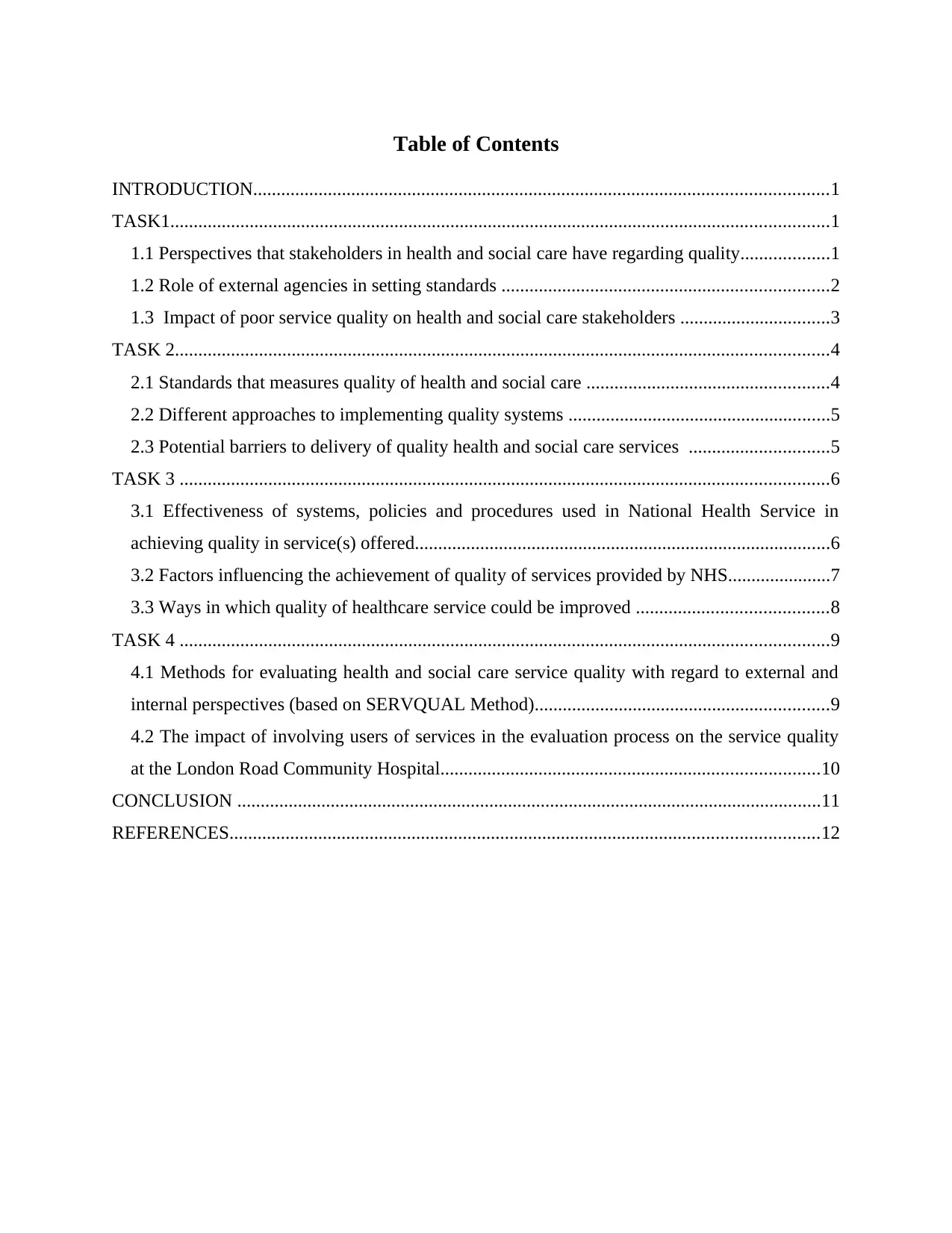
Table of Contents
INTRODUCTION...........................................................................................................................1
TASK1.............................................................................................................................................1
1.1 Perspectives that stakeholders in health and social care have regarding quality...................1
1.2 Role of external agencies in setting standards ......................................................................2
1.3 Impact of poor service quality on health and social care stakeholders ................................3
TASK 2............................................................................................................................................4
2.1 Standards that measures quality of health and social care ....................................................4
2.2 Different approaches to implementing quality systems ........................................................5
2.3 Potential barriers to delivery of quality health and social care services ..............................5
TASK 3 ...........................................................................................................................................6
3.1 Effectiveness of systems, policies and procedures used in National Health Service in
achieving quality in service(s) offered.........................................................................................6
3.2 Factors influencing the achievement of quality of services provided by NHS......................7
3.3 Ways in which quality of healthcare service could be improved .........................................8
TASK 4 ...........................................................................................................................................9
4.1 Methods for evaluating health and social care service quality with regard to external and
internal perspectives (based on SERVQUAL Method)...............................................................9
4.2 The impact of involving users of services in the evaluation process on the service quality
at the London Road Community Hospital.................................................................................10
CONCLUSION .............................................................................................................................11
REFERENCES..............................................................................................................................12
INTRODUCTION...........................................................................................................................1
TASK1.............................................................................................................................................1
1.1 Perspectives that stakeholders in health and social care have regarding quality...................1
1.2 Role of external agencies in setting standards ......................................................................2
1.3 Impact of poor service quality on health and social care stakeholders ................................3
TASK 2............................................................................................................................................4
2.1 Standards that measures quality of health and social care ....................................................4
2.2 Different approaches to implementing quality systems ........................................................5
2.3 Potential barriers to delivery of quality health and social care services ..............................5
TASK 3 ...........................................................................................................................................6
3.1 Effectiveness of systems, policies and procedures used in National Health Service in
achieving quality in service(s) offered.........................................................................................6
3.2 Factors influencing the achievement of quality of services provided by NHS......................7
3.3 Ways in which quality of healthcare service could be improved .........................................8
TASK 4 ...........................................................................................................................................9
4.1 Methods for evaluating health and social care service quality with regard to external and
internal perspectives (based on SERVQUAL Method)...............................................................9
4.2 The impact of involving users of services in the evaluation process on the service quality
at the London Road Community Hospital.................................................................................10
CONCLUSION .............................................................................................................................11
REFERENCES..............................................................................................................................12

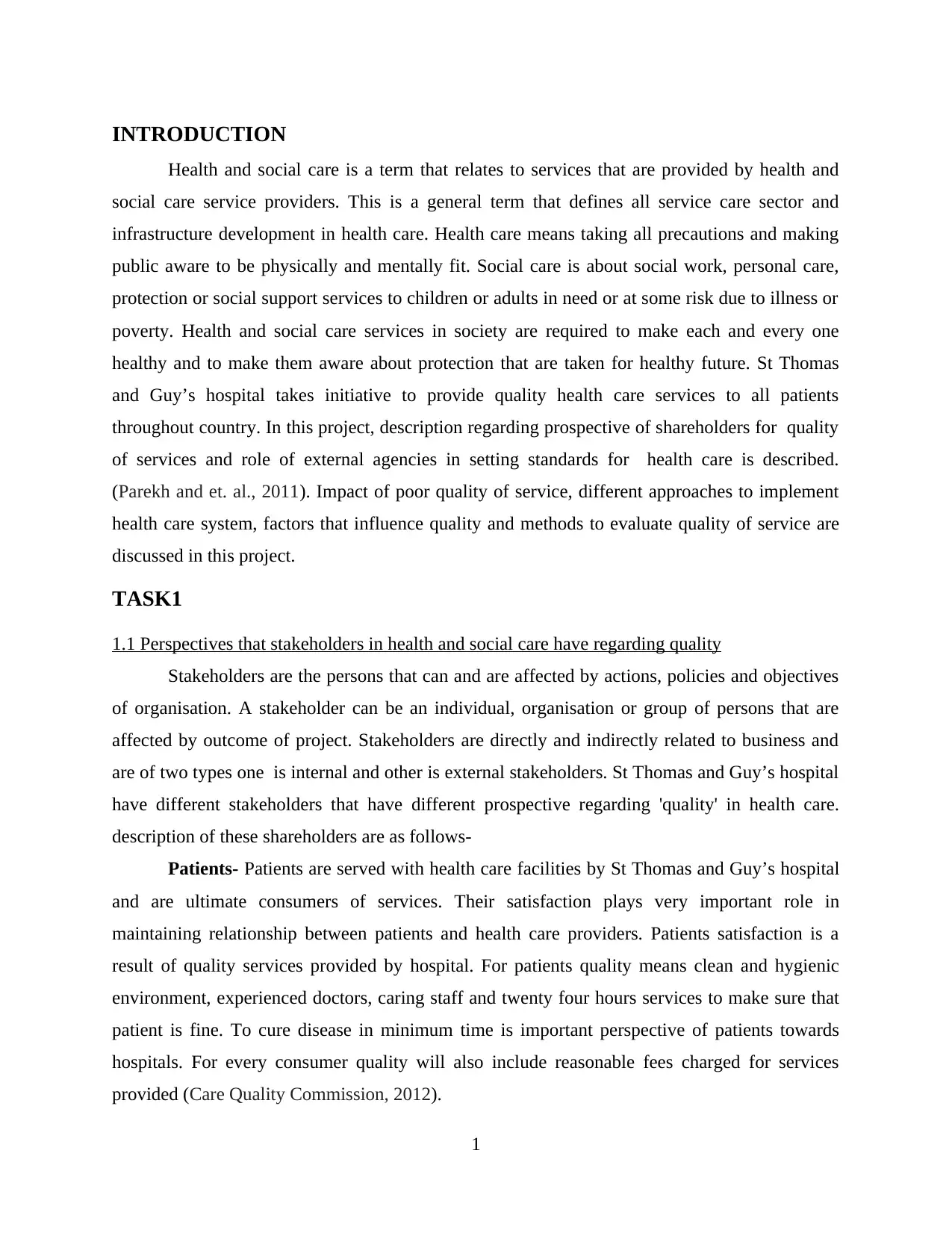
INTRODUCTION
Health and social care is a term that relates to services that are provided by health and
social care service providers. This is a general term that defines all service care sector and
infrastructure development in health care. Health care means taking all precautions and making
public aware to be physically and mentally fit. Social care is about social work, personal care,
protection or social support services to children or adults in need or at some risk due to illness or
poverty. Health and social care services in society are required to make each and every one
healthy and to make them aware about protection that are taken for healthy future. St Thomas
and Guy’s hospital takes initiative to provide quality health care services to all patients
throughout country. In this project, description regarding prospective of shareholders for quality
of services and role of external agencies in setting standards for health care is described.
(Parekh and et. al., 2011). Impact of poor quality of service, different approaches to implement
health care system, factors that influence quality and methods to evaluate quality of service are
discussed in this project.
TASK1
1.1 Perspectives that stakeholders in health and social care have regarding quality
Stakeholders are the persons that can and are affected by actions, policies and objectives
of organisation. A stakeholder can be an individual, organisation or group of persons that are
affected by outcome of project. Stakeholders are directly and indirectly related to business and
are of two types one is internal and other is external stakeholders. St Thomas and Guy’s hospital
have different stakeholders that have different prospective regarding 'quality' in health care.
description of these shareholders are as follows-
Patients- Patients are served with health care facilities by St Thomas and Guy’s hospital
and are ultimate consumers of services. Their satisfaction plays very important role in
maintaining relationship between patients and health care providers. Patients satisfaction is a
result of quality services provided by hospital. For patients quality means clean and hygienic
environment, experienced doctors, caring staff and twenty four hours services to make sure that
patient is fine. To cure disease in minimum time is important perspective of patients towards
hospitals. For every consumer quality will also include reasonable fees charged for services
provided (Care Quality Commission, 2012).
1
Health and social care is a term that relates to services that are provided by health and
social care service providers. This is a general term that defines all service care sector and
infrastructure development in health care. Health care means taking all precautions and making
public aware to be physically and mentally fit. Social care is about social work, personal care,
protection or social support services to children or adults in need or at some risk due to illness or
poverty. Health and social care services in society are required to make each and every one
healthy and to make them aware about protection that are taken for healthy future. St Thomas
and Guy’s hospital takes initiative to provide quality health care services to all patients
throughout country. In this project, description regarding prospective of shareholders for quality
of services and role of external agencies in setting standards for health care is described.
(Parekh and et. al., 2011). Impact of poor quality of service, different approaches to implement
health care system, factors that influence quality and methods to evaluate quality of service are
discussed in this project.
TASK1
1.1 Perspectives that stakeholders in health and social care have regarding quality
Stakeholders are the persons that can and are affected by actions, policies and objectives
of organisation. A stakeholder can be an individual, organisation or group of persons that are
affected by outcome of project. Stakeholders are directly and indirectly related to business and
are of two types one is internal and other is external stakeholders. St Thomas and Guy’s hospital
have different stakeholders that have different prospective regarding 'quality' in health care.
description of these shareholders are as follows-
Patients- Patients are served with health care facilities by St Thomas and Guy’s hospital
and are ultimate consumers of services. Their satisfaction plays very important role in
maintaining relationship between patients and health care providers. Patients satisfaction is a
result of quality services provided by hospital. For patients quality means clean and hygienic
environment, experienced doctors, caring staff and twenty four hours services to make sure that
patient is fine. To cure disease in minimum time is important perspective of patients towards
hospitals. For every consumer quality will also include reasonable fees charged for services
provided (Care Quality Commission, 2012).
1
Secure Best Marks with AI Grader
Need help grading? Try our AI Grader for instant feedback on your assignments.
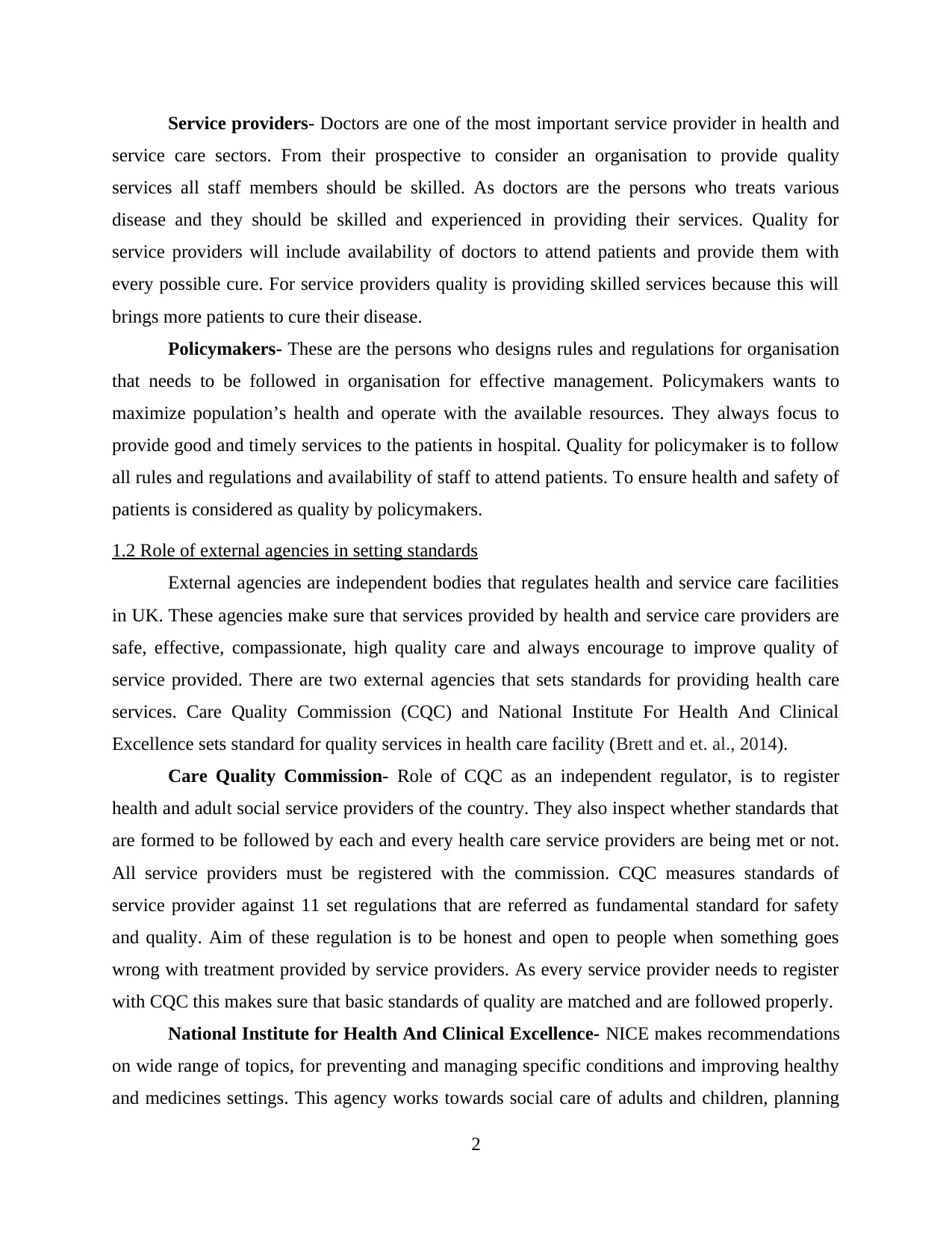
Service providers- Doctors are one of the most important service provider in health and
service care sectors. From their prospective to consider an organisation to provide quality
services all staff members should be skilled. As doctors are the persons who treats various
disease and they should be skilled and experienced in providing their services. Quality for
service providers will include availability of doctors to attend patients and provide them with
every possible cure. For service providers quality is providing skilled services because this will
brings more patients to cure their disease.
Policymakers- These are the persons who designs rules and regulations for organisation
that needs to be followed in organisation for effective management. Policymakers wants to
maximize population’s health and operate with the available resources. They always focus to
provide good and timely services to the patients in hospital. Quality for policymaker is to follow
all rules and regulations and availability of staff to attend patients. To ensure health and safety of
patients is considered as quality by policymakers.
1.2 Role of external agencies in setting standards
External agencies are independent bodies that regulates health and service care facilities
in UK. These agencies make sure that services provided by health and service care providers are
safe, effective, compassionate, high quality care and always encourage to improve quality of
service provided. There are two external agencies that sets standards for providing health care
services. Care Quality Commission (CQC) and National Institute For Health And Clinical
Excellence sets standard for quality services in health care facility (Brett and et. al., 2014).
Care Quality Commission- Role of CQC as an independent regulator, is to register
health and adult social service providers of the country. They also inspect whether standards that
are formed to be followed by each and every health care service providers are being met or not.
All service providers must be registered with the commission. CQC measures standards of
service provider against 11 set regulations that are referred as fundamental standard for safety
and quality. Aim of these regulation is to be honest and open to people when something goes
wrong with treatment provided by service providers. As every service provider needs to register
with CQC this makes sure that basic standards of quality are matched and are followed properly.
National Institute for Health And Clinical Excellence- NICE makes recommendations
on wide range of topics, for preventing and managing specific conditions and improving healthy
and medicines settings. This agency works towards social care of adults and children, planning
2
service care sectors. From their prospective to consider an organisation to provide quality
services all staff members should be skilled. As doctors are the persons who treats various
disease and they should be skilled and experienced in providing their services. Quality for
service providers will include availability of doctors to attend patients and provide them with
every possible cure. For service providers quality is providing skilled services because this will
brings more patients to cure their disease.
Policymakers- These are the persons who designs rules and regulations for organisation
that needs to be followed in organisation for effective management. Policymakers wants to
maximize population’s health and operate with the available resources. They always focus to
provide good and timely services to the patients in hospital. Quality for policymaker is to follow
all rules and regulations and availability of staff to attend patients. To ensure health and safety of
patients is considered as quality by policymakers.
1.2 Role of external agencies in setting standards
External agencies are independent bodies that regulates health and service care facilities
in UK. These agencies make sure that services provided by health and service care providers are
safe, effective, compassionate, high quality care and always encourage to improve quality of
service provided. There are two external agencies that sets standards for providing health care
services. Care Quality Commission (CQC) and National Institute For Health And Clinical
Excellence sets standard for quality services in health care facility (Brett and et. al., 2014).
Care Quality Commission- Role of CQC as an independent regulator, is to register
health and adult social service providers of the country. They also inspect whether standards that
are formed to be followed by each and every health care service providers are being met or not.
All service providers must be registered with the commission. CQC measures standards of
service provider against 11 set regulations that are referred as fundamental standard for safety
and quality. Aim of these regulation is to be honest and open to people when something goes
wrong with treatment provided by service providers. As every service provider needs to register
with CQC this makes sure that basic standards of quality are matched and are followed properly.
National Institute for Health And Clinical Excellence- NICE makes recommendations
on wide range of topics, for preventing and managing specific conditions and improving healthy
and medicines settings. This agency works towards social care of adults and children, planning
2

broader services and intervention to improve health facility. This agency has guidelines on
appropriate treatment and care of people with specific disease (Barlow Roehrich and Wright,
2013). Organisation's main aim is to improve quality of healthcare by changing process and
increasing chances of peoples of getting well as soon as possible. As organisation provides set
rules and guidelines that are followed by providers of healthcare facility dealing with specific
disease. This improves quality of service that deals with special diseases. NICH prevent ill
health, promote and protect good health, improve quality of service and adopt and provide health
and social care services all these guidelines helps to setting standard for good health care facility.
1.3 Impact of poor service quality on health and social care stakeholders
There are various stakeholders that are affected by actions of organisation. Poor quality
of service by St Thomas and Guy’s hospital will affects its different stakeholders but each
stakeholder will affected differently.
On Patients- As satisfaction from services received is based on quality of service
provided by service providers of healthcare facility. Poor quality of services will leads to
dissatisfied consumers and that directly affects number of patients that visits hospital to cure
their disease. When proper clean environment is not maintained by hospitals that leads various
infactions to patients and also to visitors with them and consumers avoids these hospitals
(Cameron and et. al., 2014). When patients are not attended on time and lack of availability of
staff shows hospitals are not that much concern about good health of their patients. This creates
negative image and patients do not consider these type of hospitals to take any service.
On Service providers- Hospitals that do not provides quality services loses its
experienced and skilled staff. A reputed and experienced doctor wants to join its name with
organisation which is highly renounced. When quality is not maintained in hospitals to provide
health and service care facilities and any mishappening takes place that spoils image of service
provider. This makes service provider to take decision not to work with the hospitals and
hospitals looses efficient staff.
On Policymakers- Policymakers design policy of organisation to maintain quality in
services provided by business. When these standards are not met and poor quality of services are
provided by organisation different measures are taken to know reason regarding poor quality.
Variation in quality and its impact on organisation is evaluated and an effective process is
3
appropriate treatment and care of people with specific disease (Barlow Roehrich and Wright,
2013). Organisation's main aim is to improve quality of healthcare by changing process and
increasing chances of peoples of getting well as soon as possible. As organisation provides set
rules and guidelines that are followed by providers of healthcare facility dealing with specific
disease. This improves quality of service that deals with special diseases. NICH prevent ill
health, promote and protect good health, improve quality of service and adopt and provide health
and social care services all these guidelines helps to setting standard for good health care facility.
1.3 Impact of poor service quality on health and social care stakeholders
There are various stakeholders that are affected by actions of organisation. Poor quality
of service by St Thomas and Guy’s hospital will affects its different stakeholders but each
stakeholder will affected differently.
On Patients- As satisfaction from services received is based on quality of service
provided by service providers of healthcare facility. Poor quality of services will leads to
dissatisfied consumers and that directly affects number of patients that visits hospital to cure
their disease. When proper clean environment is not maintained by hospitals that leads various
infactions to patients and also to visitors with them and consumers avoids these hospitals
(Cameron and et. al., 2014). When patients are not attended on time and lack of availability of
staff shows hospitals are not that much concern about good health of their patients. This creates
negative image and patients do not consider these type of hospitals to take any service.
On Service providers- Hospitals that do not provides quality services loses its
experienced and skilled staff. A reputed and experienced doctor wants to join its name with
organisation which is highly renounced. When quality is not maintained in hospitals to provide
health and service care facilities and any mishappening takes place that spoils image of service
provider. This makes service provider to take decision not to work with the hospitals and
hospitals looses efficient staff.
On Policymakers- Policymakers design policy of organisation to maintain quality in
services provided by business. When these standards are not met and poor quality of services are
provided by organisation different measures are taken to know reason regarding poor quality.
Variation in quality and its impact on organisation is evaluated and an effective process is
3
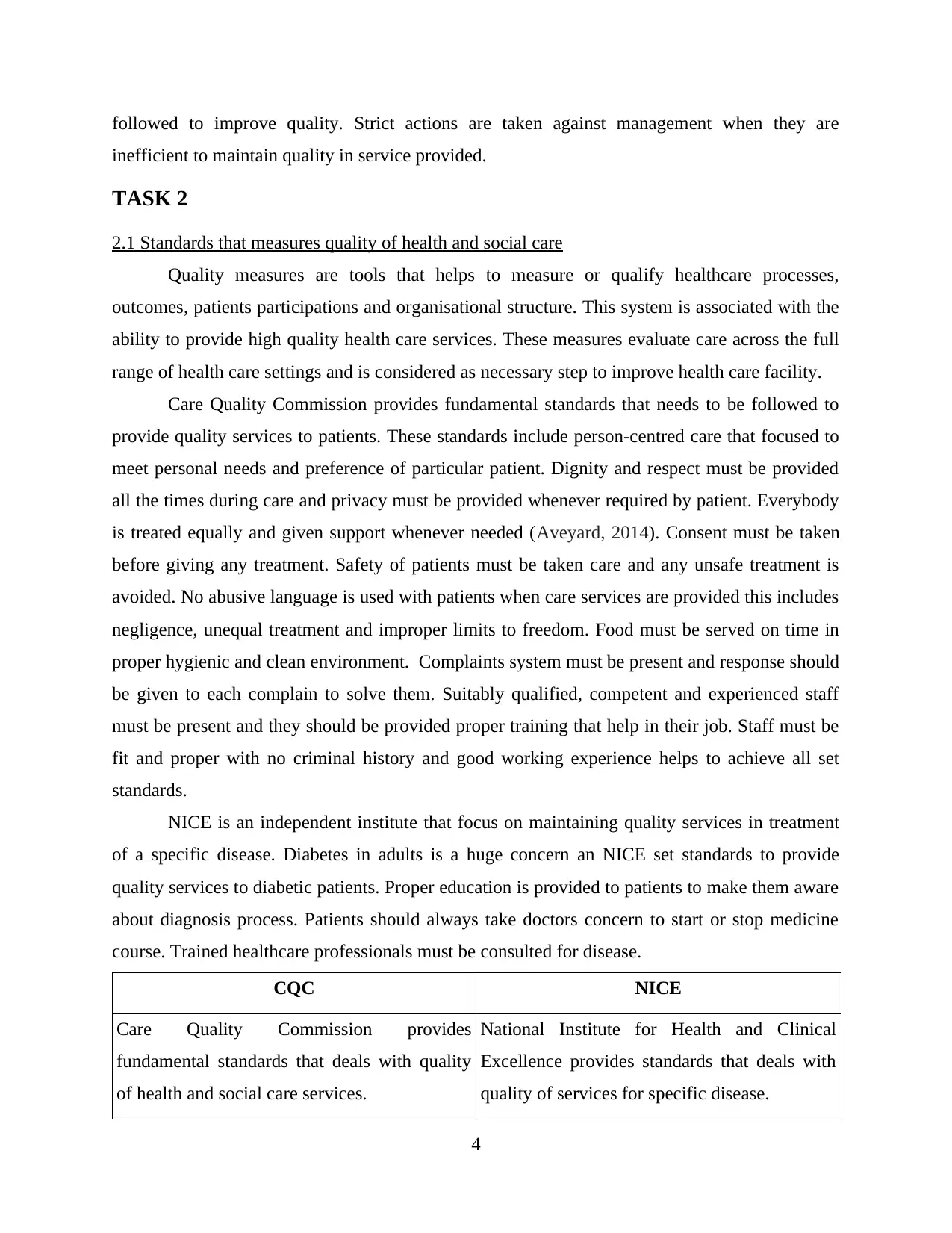
followed to improve quality. Strict actions are taken against management when they are
inefficient to maintain quality in service provided.
TASK 2
2.1 Standards that measures quality of health and social care
Quality measures are tools that helps to measure or qualify healthcare processes,
outcomes, patients participations and organisational structure. This system is associated with the
ability to provide high quality health care services. These measures evaluate care across the full
range of health care settings and is considered as necessary step to improve health care facility.
Care Quality Commission provides fundamental standards that needs to be followed to
provide quality services to patients. These standards include person-centred care that focused to
meet personal needs and preference of particular patient. Dignity and respect must be provided
all the times during care and privacy must be provided whenever required by patient. Everybody
is treated equally and given support whenever needed (Aveyard, 2014). Consent must be taken
before giving any treatment. Safety of patients must be taken care and any unsafe treatment is
avoided. No abusive language is used with patients when care services are provided this includes
negligence, unequal treatment and improper limits to freedom. Food must be served on time in
proper hygienic and clean environment. Complaints system must be present and response should
be given to each complain to solve them. Suitably qualified, competent and experienced staff
must be present and they should be provided proper training that help in their job. Staff must be
fit and proper with no criminal history and good working experience helps to achieve all set
standards.
NICE is an independent institute that focus on maintaining quality services in treatment
of a specific disease. Diabetes in adults is a huge concern an NICE set standards to provide
quality services to diabetic patients. Proper education is provided to patients to make them aware
about diagnosis process. Patients should always take doctors concern to start or stop medicine
course. Trained healthcare professionals must be consulted for disease.
CQC NICE
Care Quality Commission provides
fundamental standards that deals with quality
of health and social care services.
National Institute for Health and Clinical
Excellence provides standards that deals with
quality of services for specific disease.
4
inefficient to maintain quality in service provided.
TASK 2
2.1 Standards that measures quality of health and social care
Quality measures are tools that helps to measure or qualify healthcare processes,
outcomes, patients participations and organisational structure. This system is associated with the
ability to provide high quality health care services. These measures evaluate care across the full
range of health care settings and is considered as necessary step to improve health care facility.
Care Quality Commission provides fundamental standards that needs to be followed to
provide quality services to patients. These standards include person-centred care that focused to
meet personal needs and preference of particular patient. Dignity and respect must be provided
all the times during care and privacy must be provided whenever required by patient. Everybody
is treated equally and given support whenever needed (Aveyard, 2014). Consent must be taken
before giving any treatment. Safety of patients must be taken care and any unsafe treatment is
avoided. No abusive language is used with patients when care services are provided this includes
negligence, unequal treatment and improper limits to freedom. Food must be served on time in
proper hygienic and clean environment. Complaints system must be present and response should
be given to each complain to solve them. Suitably qualified, competent and experienced staff
must be present and they should be provided proper training that help in their job. Staff must be
fit and proper with no criminal history and good working experience helps to achieve all set
standards.
NICE is an independent institute that focus on maintaining quality services in treatment
of a specific disease. Diabetes in adults is a huge concern an NICE set standards to provide
quality services to diabetic patients. Proper education is provided to patients to make them aware
about diagnosis process. Patients should always take doctors concern to start or stop medicine
course. Trained healthcare professionals must be consulted for disease.
CQC NICE
Care Quality Commission provides
fundamental standards that deals with quality
of health and social care services.
National Institute for Health and Clinical
Excellence provides standards that deals with
quality of services for specific disease.
4
Paraphrase This Document
Need a fresh take? Get an instant paraphrase of this document with our AI Paraphraser
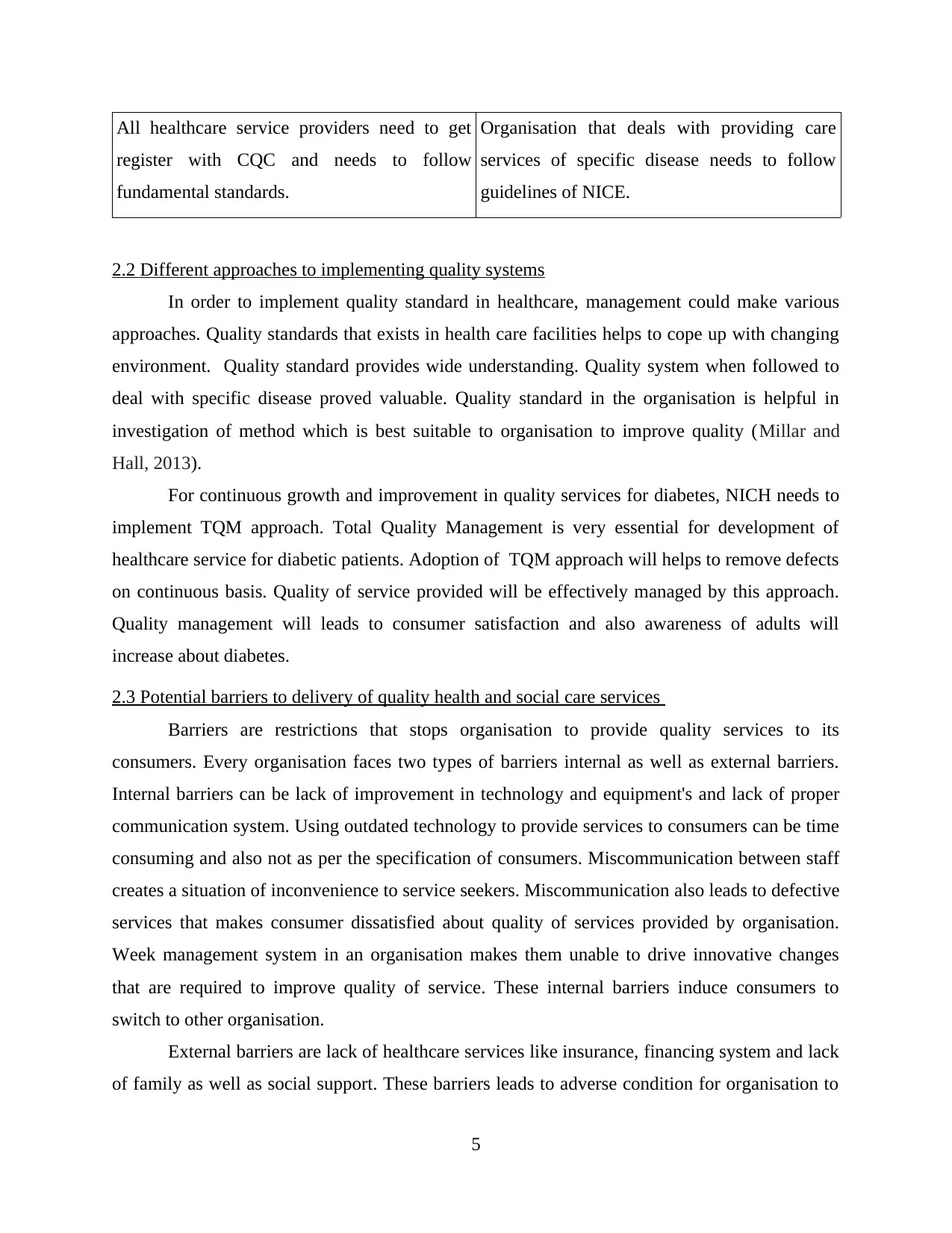
All healthcare service providers need to get
register with CQC and needs to follow
fundamental standards.
Organisation that deals with providing care
services of specific disease needs to follow
guidelines of NICE.
2.2 Different approaches to implementing quality systems
In order to implement quality standard in healthcare, management could make various
approaches. Quality standards that exists in health care facilities helps to cope up with changing
environment. Quality standard provides wide understanding. Quality system when followed to
deal with specific disease proved valuable. Quality standard in the organisation is helpful in
investigation of method which is best suitable to organisation to improve quality (Millar and
Hall, 2013).
For continuous growth and improvement in quality services for diabetes, NICH needs to
implement TQM approach. Total Quality Management is very essential for development of
healthcare service for diabetic patients. Adoption of TQM approach will helps to remove defects
on continuous basis. Quality of service provided will be effectively managed by this approach.
Quality management will leads to consumer satisfaction and also awareness of adults will
increase about diabetes.
2.3 Potential barriers to delivery of quality health and social care services
Barriers are restrictions that stops organisation to provide quality services to its
consumers. Every organisation faces two types of barriers internal as well as external barriers.
Internal barriers can be lack of improvement in technology and equipment's and lack of proper
communication system. Using outdated technology to provide services to consumers can be time
consuming and also not as per the specification of consumers. Miscommunication between staff
creates a situation of inconvenience to service seekers. Miscommunication also leads to defective
services that makes consumer dissatisfied about quality of services provided by organisation.
Week management system in an organisation makes them unable to drive innovative changes
that are required to improve quality of service. These internal barriers induce consumers to
switch to other organisation.
External barriers are lack of healthcare services like insurance, financing system and lack
of family as well as social support. These barriers leads to adverse condition for organisation to
5
register with CQC and needs to follow
fundamental standards.
Organisation that deals with providing care
services of specific disease needs to follow
guidelines of NICE.
2.2 Different approaches to implementing quality systems
In order to implement quality standard in healthcare, management could make various
approaches. Quality standards that exists in health care facilities helps to cope up with changing
environment. Quality standard provides wide understanding. Quality system when followed to
deal with specific disease proved valuable. Quality standard in the organisation is helpful in
investigation of method which is best suitable to organisation to improve quality (Millar and
Hall, 2013).
For continuous growth and improvement in quality services for diabetes, NICH needs to
implement TQM approach. Total Quality Management is very essential for development of
healthcare service for diabetic patients. Adoption of TQM approach will helps to remove defects
on continuous basis. Quality of service provided will be effectively managed by this approach.
Quality management will leads to consumer satisfaction and also awareness of adults will
increase about diabetes.
2.3 Potential barriers to delivery of quality health and social care services
Barriers are restrictions that stops organisation to provide quality services to its
consumers. Every organisation faces two types of barriers internal as well as external barriers.
Internal barriers can be lack of improvement in technology and equipment's and lack of proper
communication system. Using outdated technology to provide services to consumers can be time
consuming and also not as per the specification of consumers. Miscommunication between staff
creates a situation of inconvenience to service seekers. Miscommunication also leads to defective
services that makes consumer dissatisfied about quality of services provided by organisation.
Week management system in an organisation makes them unable to drive innovative changes
that are required to improve quality of service. These internal barriers induce consumers to
switch to other organisation.
External barriers are lack of healthcare services like insurance, financing system and lack
of family as well as social support. These barriers leads to adverse condition for organisation to
5

deal with. Lack of health insurance results in inefficiency as consumers prefer organisation that
have easy clearance system of health insurance (Major and Savin-Baden, 2012). Poor financial
system can be a reason behind mismanagement as due to non-availability of funds planning
cannot be implemented properly.
TASK 3
3.1 Effectiveness of systems, policies and procedures used in National Health Service in
achieving quality in service(s) offered
NHS offered health care services in the United Kingdom. NHS has implemented various
strategies and plans to achieve and maintain the quality of services offered by it. The plans and
strategies have been successful to a great extent for achieving the quality standards. It has earned
£27 billion over the past 5 years and the progress is increasing every year. It has online services
portals due to which 34% of the people have accessed to urgent and emergency care advice and
the hospital performance rose to 88.4%. The plans and policies have reduced the costs, improved
care for the patients and 50% of the employees have training to comply with quality standards. It
has recruited 770 trainees (Bowling, 2014). Further, the cancer survival rate is increasing 0.7%
every year and it has invested more than £37 million to boost diagnostic services for cancer
patients. Apart from this, it has achieved first place in Commonwealth Fund 2017 review of
healthcare in the world's wealthiest countries. Along with this, it has introduced new devices to
prevent medications accident by proper administration and the risk of non-compliance has
reduced by complying with World Health Organization (WHO) safety checklist.
There are many other aspects that have been achieved by NHS. It has published a Patient
Safety Alert for the people in UK. Along with this, it has established “Integrated Care Systems”
to track the resources closely for the benefit of local population. NHS has provided physical
health checks to treat patients with mental illness, it has been successful in treating more than
60% of such people. It has signed a MoU with eight ICSs which has covered 12.5 million people
under ICS programme. Further, there are some internal effectiveness that it has achieved. The
achievements are establishment of Council for Healthcare Regulatory Excellence, introduction of
whistle-blower policy, establishment of National Patient Safety Agency for collecting and
analysing the data about adverse events, NHS Modernisation Agency to improve central support
6
have easy clearance system of health insurance (Major and Savin-Baden, 2012). Poor financial
system can be a reason behind mismanagement as due to non-availability of funds planning
cannot be implemented properly.
TASK 3
3.1 Effectiveness of systems, policies and procedures used in National Health Service in
achieving quality in service(s) offered
NHS offered health care services in the United Kingdom. NHS has implemented various
strategies and plans to achieve and maintain the quality of services offered by it. The plans and
strategies have been successful to a great extent for achieving the quality standards. It has earned
£27 billion over the past 5 years and the progress is increasing every year. It has online services
portals due to which 34% of the people have accessed to urgent and emergency care advice and
the hospital performance rose to 88.4%. The plans and policies have reduced the costs, improved
care for the patients and 50% of the employees have training to comply with quality standards. It
has recruited 770 trainees (Bowling, 2014). Further, the cancer survival rate is increasing 0.7%
every year and it has invested more than £37 million to boost diagnostic services for cancer
patients. Apart from this, it has achieved first place in Commonwealth Fund 2017 review of
healthcare in the world's wealthiest countries. Along with this, it has introduced new devices to
prevent medications accident by proper administration and the risk of non-compliance has
reduced by complying with World Health Organization (WHO) safety checklist.
There are many other aspects that have been achieved by NHS. It has published a Patient
Safety Alert for the people in UK. Along with this, it has established “Integrated Care Systems”
to track the resources closely for the benefit of local population. NHS has provided physical
health checks to treat patients with mental illness, it has been successful in treating more than
60% of such people. It has signed a MoU with eight ICSs which has covered 12.5 million people
under ICS programme. Further, there are some internal effectiveness that it has achieved. The
achievements are establishment of Council for Healthcare Regulatory Excellence, introduction of
whistle-blower policy, establishment of National Patient Safety Agency for collecting and
analysing the data about adverse events, NHS Modernisation Agency to improve central support
6
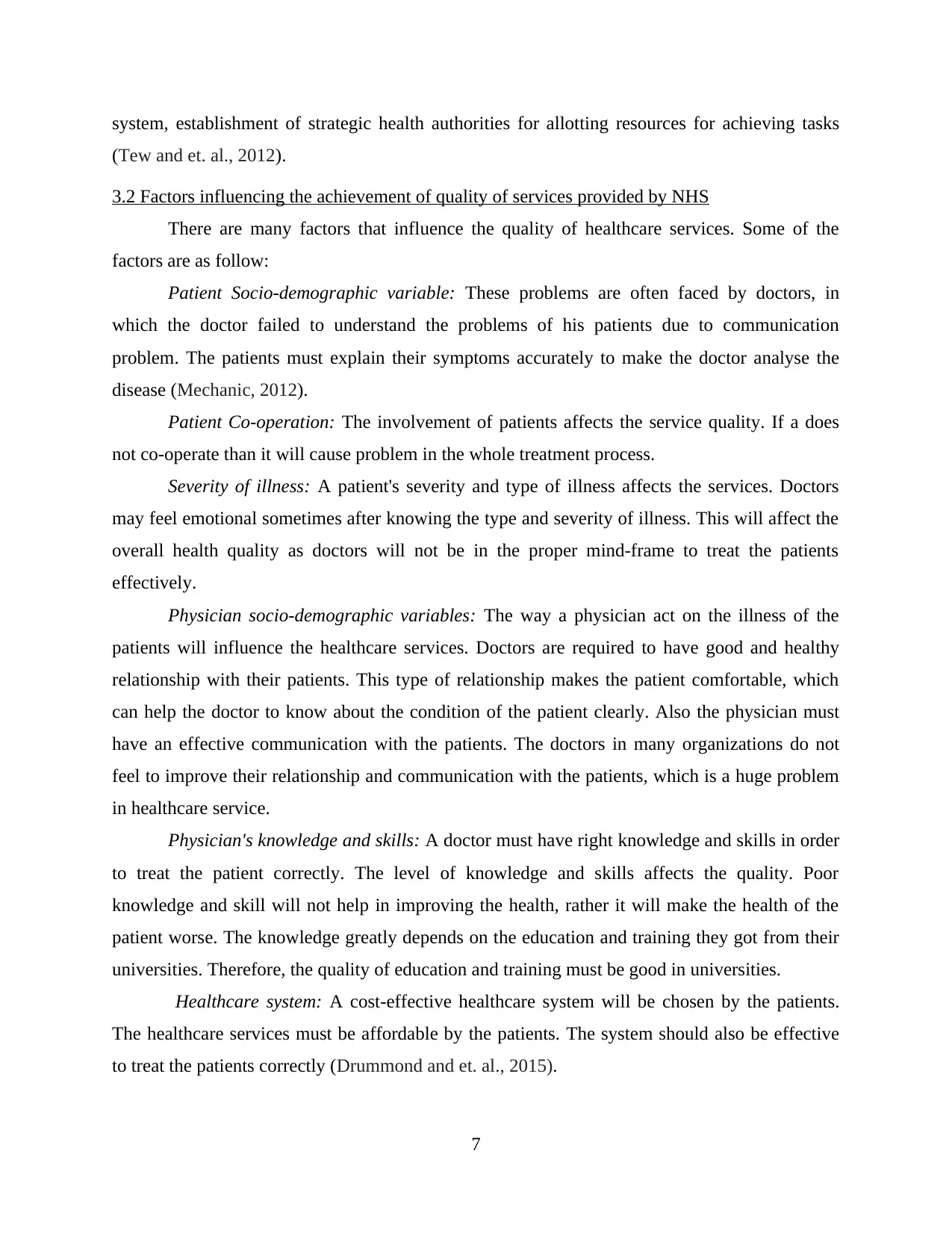
system, establishment of strategic health authorities for allotting resources for achieving tasks
(Tew and et. al., 2012).
3.2 Factors influencing the achievement of quality of services provided by NHS
There are many factors that influence the quality of healthcare services. Some of the
factors are as follow:
Patient Socio-demographic variable: These problems are often faced by doctors, in
which the doctor failed to understand the problems of his patients due to communication
problem. The patients must explain their symptoms accurately to make the doctor analyse the
disease (Mechanic, 2012).
Patient Co-operation: The involvement of patients affects the service quality. If a does
not co-operate than it will cause problem in the whole treatment process.
Severity of illness: A patient's severity and type of illness affects the services. Doctors
may feel emotional sometimes after knowing the type and severity of illness. This will affect the
overall health quality as doctors will not be in the proper mind-frame to treat the patients
effectively.
Physician socio-demographic variables: The way a physician act on the illness of the
patients will influence the healthcare services. Doctors are required to have good and healthy
relationship with their patients. This type of relationship makes the patient comfortable, which
can help the doctor to know about the condition of the patient clearly. Also the physician must
have an effective communication with the patients. The doctors in many organizations do not
feel to improve their relationship and communication with the patients, which is a huge problem
in healthcare service.
Physician's knowledge and skills: A doctor must have right knowledge and skills in order
to treat the patient correctly. The level of knowledge and skills affects the quality. Poor
knowledge and skill will not help in improving the health, rather it will make the health of the
patient worse. The knowledge greatly depends on the education and training they got from their
universities. Therefore, the quality of education and training must be good in universities.
Healthcare system: A cost-effective healthcare system will be chosen by the patients.
The healthcare services must be affordable by the patients. The system should also be effective
to treat the patients correctly (Drummond and et. al., 2015).
7
(Tew and et. al., 2012).
3.2 Factors influencing the achievement of quality of services provided by NHS
There are many factors that influence the quality of healthcare services. Some of the
factors are as follow:
Patient Socio-demographic variable: These problems are often faced by doctors, in
which the doctor failed to understand the problems of his patients due to communication
problem. The patients must explain their symptoms accurately to make the doctor analyse the
disease (Mechanic, 2012).
Patient Co-operation: The involvement of patients affects the service quality. If a does
not co-operate than it will cause problem in the whole treatment process.
Severity of illness: A patient's severity and type of illness affects the services. Doctors
may feel emotional sometimes after knowing the type and severity of illness. This will affect the
overall health quality as doctors will not be in the proper mind-frame to treat the patients
effectively.
Physician socio-demographic variables: The way a physician act on the illness of the
patients will influence the healthcare services. Doctors are required to have good and healthy
relationship with their patients. This type of relationship makes the patient comfortable, which
can help the doctor to know about the condition of the patient clearly. Also the physician must
have an effective communication with the patients. The doctors in many organizations do not
feel to improve their relationship and communication with the patients, which is a huge problem
in healthcare service.
Physician's knowledge and skills: A doctor must have right knowledge and skills in order
to treat the patient correctly. The level of knowledge and skills affects the quality. Poor
knowledge and skill will not help in improving the health, rather it will make the health of the
patient worse. The knowledge greatly depends on the education and training they got from their
universities. Therefore, the quality of education and training must be good in universities.
Healthcare system: A cost-effective healthcare system will be chosen by the patients.
The healthcare services must be affordable by the patients. The system should also be effective
to treat the patients correctly (Drummond and et. al., 2015).
7
Secure Best Marks with AI Grader
Need help grading? Try our AI Grader for instant feedback on your assignments.
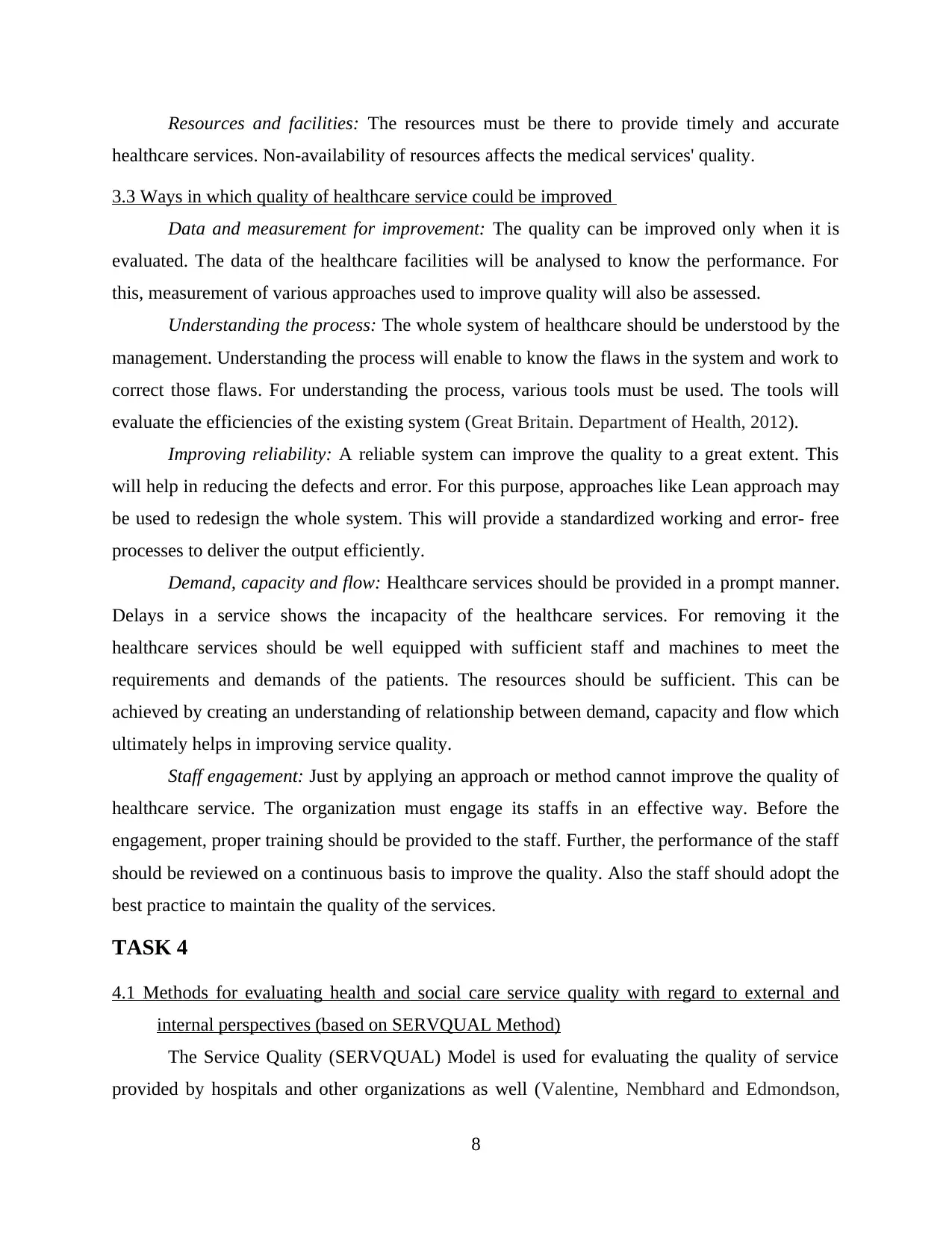
Resources and facilities: The resources must be there to provide timely and accurate
healthcare services. Non-availability of resources affects the medical services' quality.
3.3 Ways in which quality of healthcare service could be improved
Data and measurement for improvement: The quality can be improved only when it is
evaluated. The data of the healthcare facilities will be analysed to know the performance. For
this, measurement of various approaches used to improve quality will also be assessed.
Understanding the process: The whole system of healthcare should be understood by the
management. Understanding the process will enable to know the flaws in the system and work to
correct those flaws. For understanding the process, various tools must be used. The tools will
evaluate the efficiencies of the existing system (Great Britain. Department of Health, 2012).
Improving reliability: A reliable system can improve the quality to a great extent. This
will help in reducing the defects and error. For this purpose, approaches like Lean approach may
be used to redesign the whole system. This will provide a standardized working and error- free
processes to deliver the output efficiently.
Demand, capacity and flow: Healthcare services should be provided in a prompt manner.
Delays in a service shows the incapacity of the healthcare services. For removing it the
healthcare services should be well equipped with sufficient staff and machines to meet the
requirements and demands of the patients. The resources should be sufficient. This can be
achieved by creating an understanding of relationship between demand, capacity and flow which
ultimately helps in improving service quality.
Staff engagement: Just by applying an approach or method cannot improve the quality of
healthcare service. The organization must engage its staffs in an effective way. Before the
engagement, proper training should be provided to the staff. Further, the performance of the staff
should be reviewed on a continuous basis to improve the quality. Also the staff should adopt the
best practice to maintain the quality of the services.
TASK 4
4.1 Methods for evaluating health and social care service quality with regard to external and
internal perspectives (based on SERVQUAL Method)
The Service Quality (SERVQUAL) Model is used for evaluating the quality of service
provided by hospitals and other organizations as well (Valentine, Nembhard and Edmondson,
8
healthcare services. Non-availability of resources affects the medical services' quality.
3.3 Ways in which quality of healthcare service could be improved
Data and measurement for improvement: The quality can be improved only when it is
evaluated. The data of the healthcare facilities will be analysed to know the performance. For
this, measurement of various approaches used to improve quality will also be assessed.
Understanding the process: The whole system of healthcare should be understood by the
management. Understanding the process will enable to know the flaws in the system and work to
correct those flaws. For understanding the process, various tools must be used. The tools will
evaluate the efficiencies of the existing system (Great Britain. Department of Health, 2012).
Improving reliability: A reliable system can improve the quality to a great extent. This
will help in reducing the defects and error. For this purpose, approaches like Lean approach may
be used to redesign the whole system. This will provide a standardized working and error- free
processes to deliver the output efficiently.
Demand, capacity and flow: Healthcare services should be provided in a prompt manner.
Delays in a service shows the incapacity of the healthcare services. For removing it the
healthcare services should be well equipped with sufficient staff and machines to meet the
requirements and demands of the patients. The resources should be sufficient. This can be
achieved by creating an understanding of relationship between demand, capacity and flow which
ultimately helps in improving service quality.
Staff engagement: Just by applying an approach or method cannot improve the quality of
healthcare service. The organization must engage its staffs in an effective way. Before the
engagement, proper training should be provided to the staff. Further, the performance of the staff
should be reviewed on a continuous basis to improve the quality. Also the staff should adopt the
best practice to maintain the quality of the services.
TASK 4
4.1 Methods for evaluating health and social care service quality with regard to external and
internal perspectives (based on SERVQUAL Method)
The Service Quality (SERVQUAL) Model is used for evaluating the quality of service
provided by hospitals and other organizations as well (Valentine, Nembhard and Edmondson,
8
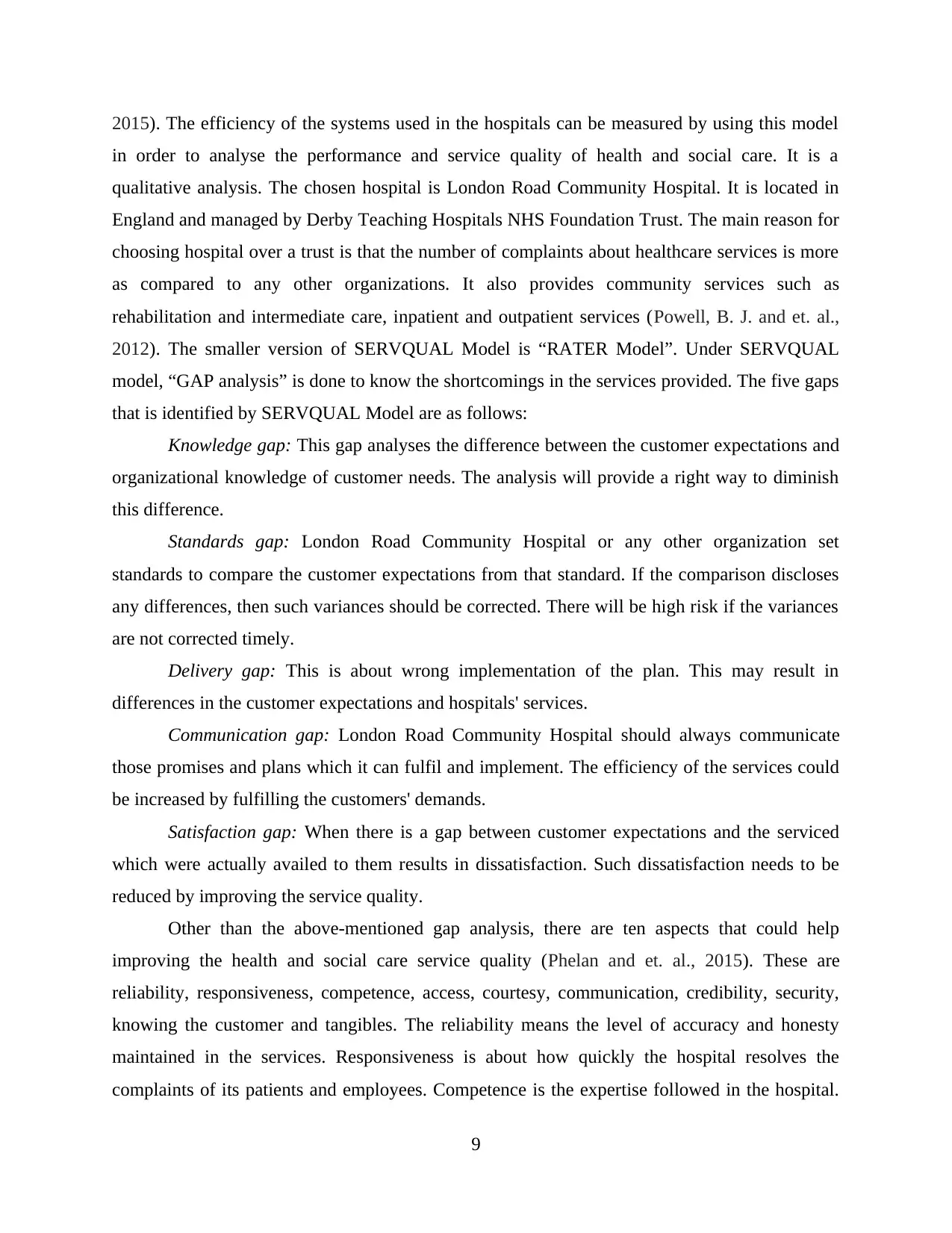
2015). The efficiency of the systems used in the hospitals can be measured by using this model
in order to analyse the performance and service quality of health and social care. It is a
qualitative analysis. The chosen hospital is London Road Community Hospital. It is located in
England and managed by Derby Teaching Hospitals NHS Foundation Trust. The main reason for
choosing hospital over a trust is that the number of complaints about healthcare services is more
as compared to any other organizations. It also provides community services such as
rehabilitation and intermediate care, inpatient and outpatient services (Powell, B. J. and et. al.,
2012). The smaller version of SERVQUAL Model is “RATER Model”. Under SERVQUAL
model, “GAP analysis” is done to know the shortcomings in the services provided. The five gaps
that is identified by SERVQUAL Model are as follows:
Knowledge gap: This gap analyses the difference between the customer expectations and
organizational knowledge of customer needs. The analysis will provide a right way to diminish
this difference.
Standards gap: London Road Community Hospital or any other organization set
standards to compare the customer expectations from that standard. If the comparison discloses
any differences, then such variances should be corrected. There will be high risk if the variances
are not corrected timely.
Delivery gap: This is about wrong implementation of the plan. This may result in
differences in the customer expectations and hospitals' services.
Communication gap: London Road Community Hospital should always communicate
those promises and plans which it can fulfil and implement. The efficiency of the services could
be increased by fulfilling the customers' demands.
Satisfaction gap: When there is a gap between customer expectations and the serviced
which were actually availed to them results in dissatisfaction. Such dissatisfaction needs to be
reduced by improving the service quality.
Other than the above-mentioned gap analysis, there are ten aspects that could help
improving the health and social care service quality (Phelan and et. al., 2015). These are
reliability, responsiveness, competence, access, courtesy, communication, credibility, security,
knowing the customer and tangibles. The reliability means the level of accuracy and honesty
maintained in the services. Responsiveness is about how quickly the hospital resolves the
complaints of its patients and employees. Competence is the expertise followed in the hospital.
9
in order to analyse the performance and service quality of health and social care. It is a
qualitative analysis. The chosen hospital is London Road Community Hospital. It is located in
England and managed by Derby Teaching Hospitals NHS Foundation Trust. The main reason for
choosing hospital over a trust is that the number of complaints about healthcare services is more
as compared to any other organizations. It also provides community services such as
rehabilitation and intermediate care, inpatient and outpatient services (Powell, B. J. and et. al.,
2012). The smaller version of SERVQUAL Model is “RATER Model”. Under SERVQUAL
model, “GAP analysis” is done to know the shortcomings in the services provided. The five gaps
that is identified by SERVQUAL Model are as follows:
Knowledge gap: This gap analyses the difference between the customer expectations and
organizational knowledge of customer needs. The analysis will provide a right way to diminish
this difference.
Standards gap: London Road Community Hospital or any other organization set
standards to compare the customer expectations from that standard. If the comparison discloses
any differences, then such variances should be corrected. There will be high risk if the variances
are not corrected timely.
Delivery gap: This is about wrong implementation of the plan. This may result in
differences in the customer expectations and hospitals' services.
Communication gap: London Road Community Hospital should always communicate
those promises and plans which it can fulfil and implement. The efficiency of the services could
be increased by fulfilling the customers' demands.
Satisfaction gap: When there is a gap between customer expectations and the serviced
which were actually availed to them results in dissatisfaction. Such dissatisfaction needs to be
reduced by improving the service quality.
Other than the above-mentioned gap analysis, there are ten aspects that could help
improving the health and social care service quality (Phelan and et. al., 2015). These are
reliability, responsiveness, competence, access, courtesy, communication, credibility, security,
knowing the customer and tangibles. The reliability means the level of accuracy and honesty
maintained in the services. Responsiveness is about how quickly the hospital resolves the
complaints of its patients and employees. Competence is the expertise followed in the hospital.
9
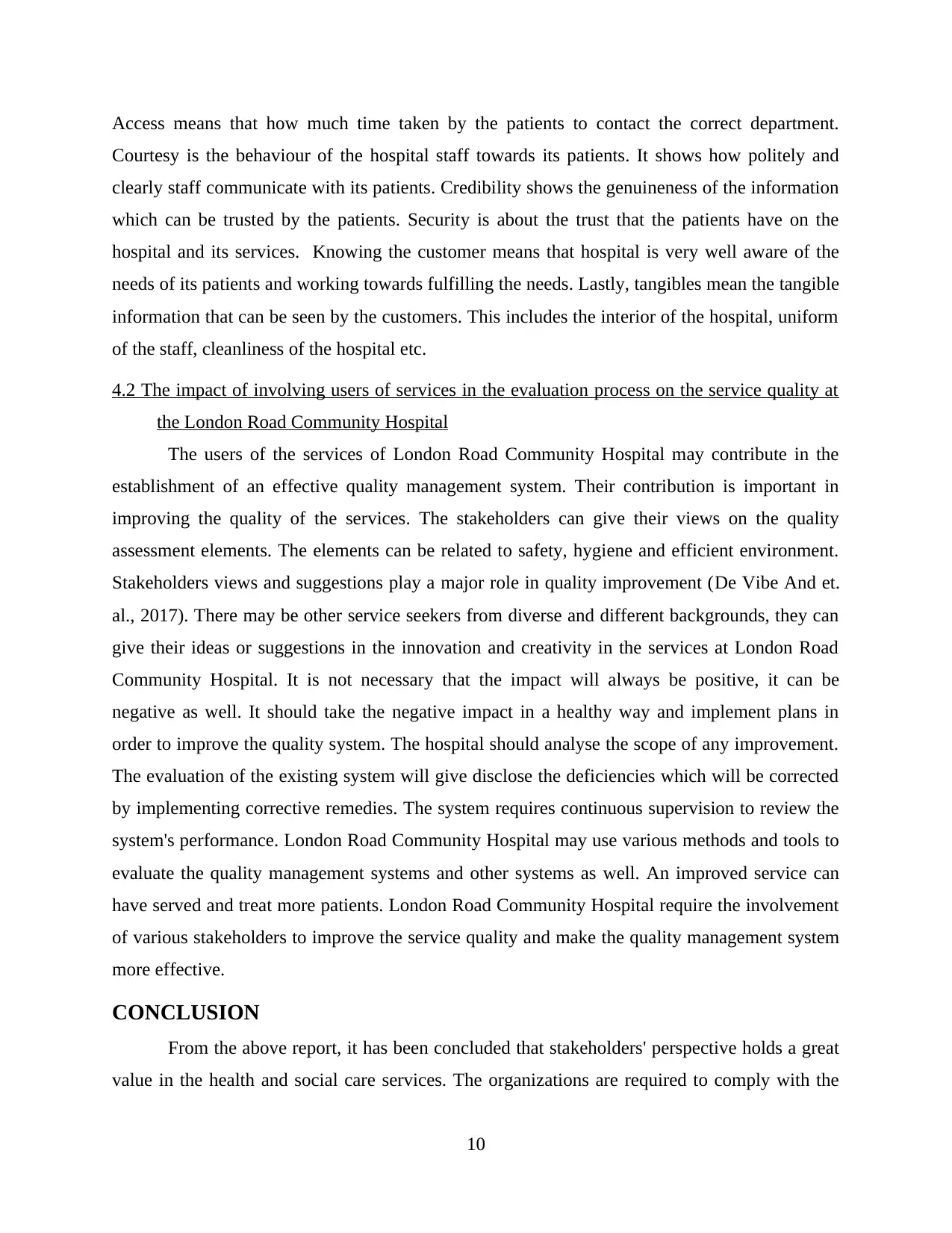
Access means that how much time taken by the patients to contact the correct department.
Courtesy is the behaviour of the hospital staff towards its patients. It shows how politely and
clearly staff communicate with its patients. Credibility shows the genuineness of the information
which can be trusted by the patients. Security is about the trust that the patients have on the
hospital and its services. Knowing the customer means that hospital is very well aware of the
needs of its patients and working towards fulfilling the needs. Lastly, tangibles mean the tangible
information that can be seen by the customers. This includes the interior of the hospital, uniform
of the staff, cleanliness of the hospital etc.
4.2 The impact of involving users of services in the evaluation process on the service quality at
the London Road Community Hospital
The users of the services of London Road Community Hospital may contribute in the
establishment of an effective quality management system. Their contribution is important in
improving the quality of the services. The stakeholders can give their views on the quality
assessment elements. The elements can be related to safety, hygiene and efficient environment.
Stakeholders views and suggestions play a major role in quality improvement (De Vibe And et.
al., 2017). There may be other service seekers from diverse and different backgrounds, they can
give their ideas or suggestions in the innovation and creativity in the services at London Road
Community Hospital. It is not necessary that the impact will always be positive, it can be
negative as well. It should take the negative impact in a healthy way and implement plans in
order to improve the quality system. The hospital should analyse the scope of any improvement.
The evaluation of the existing system will give disclose the deficiencies which will be corrected
by implementing corrective remedies. The system requires continuous supervision to review the
system's performance. London Road Community Hospital may use various methods and tools to
evaluate the quality management systems and other systems as well. An improved service can
have served and treat more patients. London Road Community Hospital require the involvement
of various stakeholders to improve the service quality and make the quality management system
more effective.
CONCLUSION
From the above report, it has been concluded that stakeholders' perspective holds a great
value in the health and social care services. The organizations are required to comply with the
10
Courtesy is the behaviour of the hospital staff towards its patients. It shows how politely and
clearly staff communicate with its patients. Credibility shows the genuineness of the information
which can be trusted by the patients. Security is about the trust that the patients have on the
hospital and its services. Knowing the customer means that hospital is very well aware of the
needs of its patients and working towards fulfilling the needs. Lastly, tangibles mean the tangible
information that can be seen by the customers. This includes the interior of the hospital, uniform
of the staff, cleanliness of the hospital etc.
4.2 The impact of involving users of services in the evaluation process on the service quality at
the London Road Community Hospital
The users of the services of London Road Community Hospital may contribute in the
establishment of an effective quality management system. Their contribution is important in
improving the quality of the services. The stakeholders can give their views on the quality
assessment elements. The elements can be related to safety, hygiene and efficient environment.
Stakeholders views and suggestions play a major role in quality improvement (De Vibe And et.
al., 2017). There may be other service seekers from diverse and different backgrounds, they can
give their ideas or suggestions in the innovation and creativity in the services at London Road
Community Hospital. It is not necessary that the impact will always be positive, it can be
negative as well. It should take the negative impact in a healthy way and implement plans in
order to improve the quality system. The hospital should analyse the scope of any improvement.
The evaluation of the existing system will give disclose the deficiencies which will be corrected
by implementing corrective remedies. The system requires continuous supervision to review the
system's performance. London Road Community Hospital may use various methods and tools to
evaluate the quality management systems and other systems as well. An improved service can
have served and treat more patients. London Road Community Hospital require the involvement
of various stakeholders to improve the service quality and make the quality management system
more effective.
CONCLUSION
From the above report, it has been concluded that stakeholders' perspective holds a great
value in the health and social care services. The organizations are required to comply with the
10
Paraphrase This Document
Need a fresh take? Get an instant paraphrase of this document with our AI Paraphraser
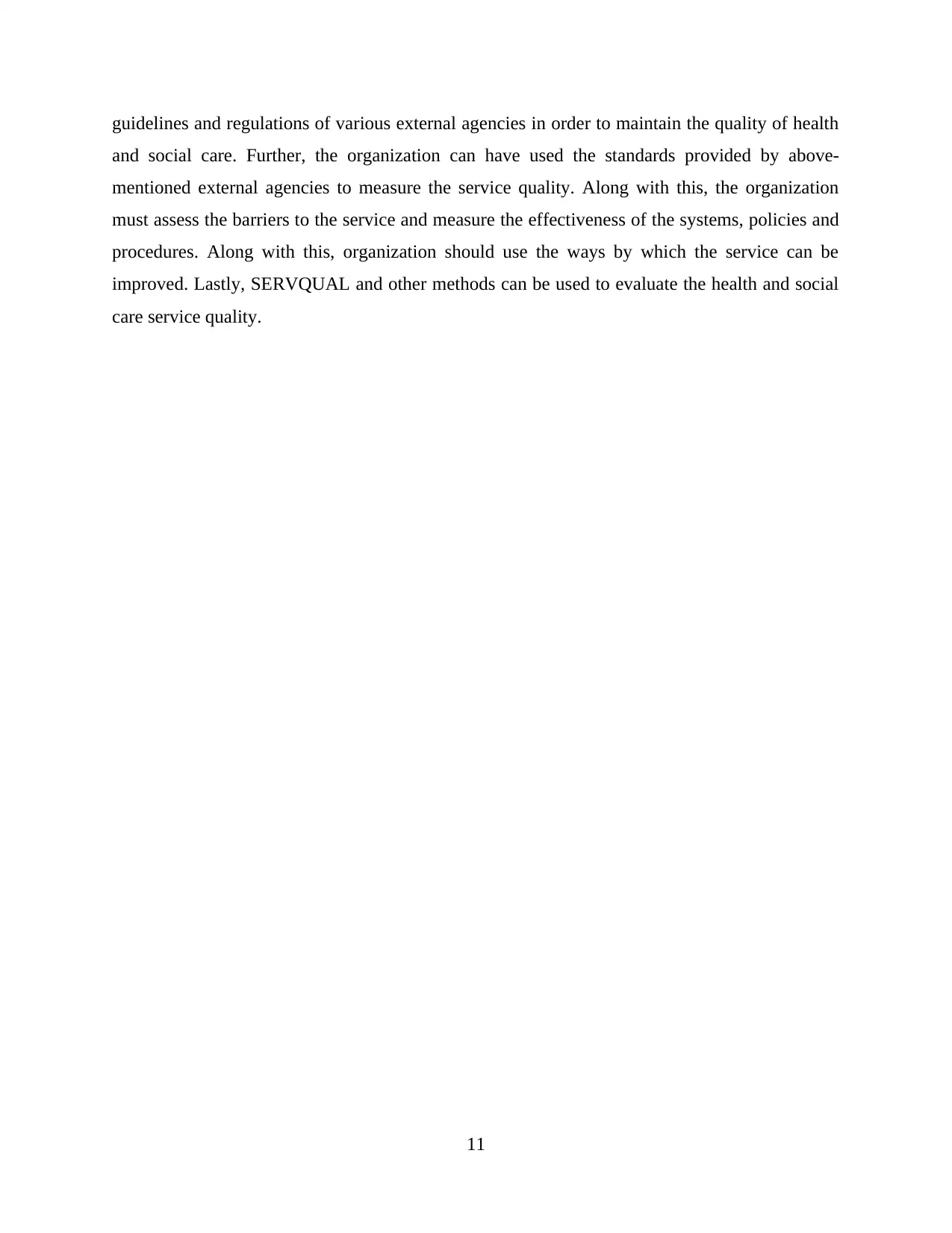
guidelines and regulations of various external agencies in order to maintain the quality of health
and social care. Further, the organization can have used the standards provided by above-
mentioned external agencies to measure the service quality. Along with this, the organization
must assess the barriers to the service and measure the effectiveness of the systems, policies and
procedures. Along with this, organization should use the ways by which the service can be
improved. Lastly, SERVQUAL and other methods can be used to evaluate the health and social
care service quality.
11
and social care. Further, the organization can have used the standards provided by above-
mentioned external agencies to measure the service quality. Along with this, the organization
must assess the barriers to the service and measure the effectiveness of the systems, policies and
procedures. Along with this, organization should use the ways by which the service can be
improved. Lastly, SERVQUAL and other methods can be used to evaluate the health and social
care service quality.
11
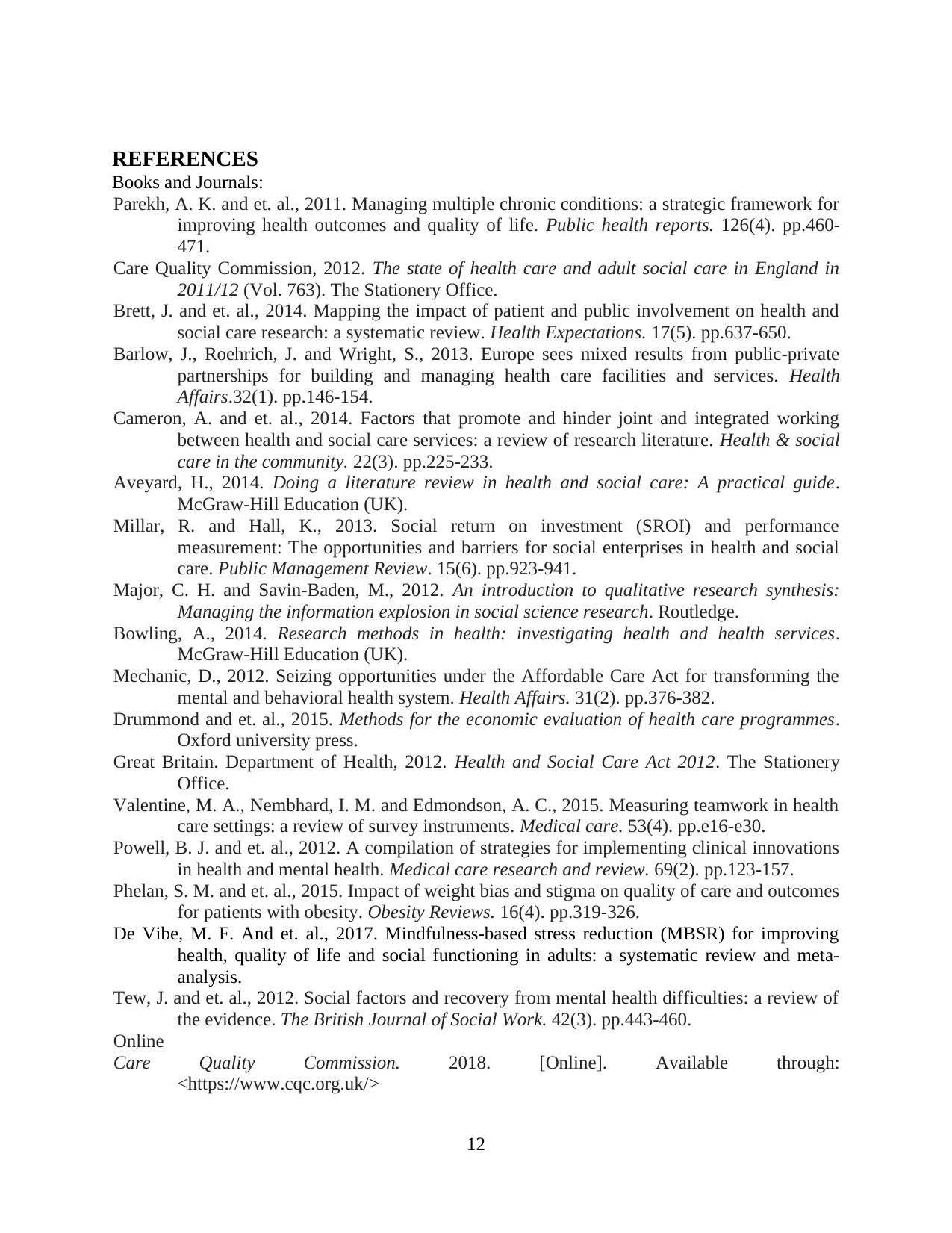
REFERENCES
Books and Journals:
Parekh, A. K. and et. al., 2011. Managing multiple chronic conditions: a strategic framework for
improving health outcomes and quality of life. Public health reports. 126(4). pp.460-
471.
Care Quality Commission, 2012. The state of health care and adult social care in England in
2011/12 (Vol. 763). The Stationery Office.
Brett, J. and et. al., 2014. Mapping the impact of patient and public involvement on health and
social care research: a systematic review. Health Expectations. 17(5). pp.637-650.
Barlow, J., Roehrich, J. and Wright, S., 2013. Europe sees mixed results from public-private
partnerships for building and managing health care facilities and services. Health
Affairs.32(1). pp.146-154.
Cameron, A. and et. al., 2014. Factors that promote and hinder joint and integrated working
between health and social care services: a review of research literature. Health & social
care in the community. 22(3). pp.225-233.
Aveyard, H., 2014. Doing a literature review in health and social care: A practical guide.
McGraw-Hill Education (UK).
Millar, R. and Hall, K., 2013. Social return on investment (SROI) and performance
measurement: The opportunities and barriers for social enterprises in health and social
care. Public Management Review. 15(6). pp.923-941.
Major, C. H. and Savin-Baden, M., 2012. An introduction to qualitative research synthesis:
Managing the information explosion in social science research. Routledge.
Bowling, A., 2014. Research methods in health: investigating health and health services.
McGraw-Hill Education (UK).
Mechanic, D., 2012. Seizing opportunities under the Affordable Care Act for transforming the
mental and behavioral health system. Health Affairs. 31(2). pp.376-382.
Drummond and et. al., 2015. Methods for the economic evaluation of health care programmes.
Oxford university press.
Great Britain. Department of Health, 2012. Health and Social Care Act 2012. The Stationery
Office.
Valentine, M. A., Nembhard, I. M. and Edmondson, A. C., 2015. Measuring teamwork in health
care settings: a review of survey instruments. Medical care. 53(4). pp.e16-e30.
Powell, B. J. and et. al., 2012. A compilation of strategies for implementing clinical innovations
in health and mental health. Medical care research and review. 69(2). pp.123-157.
Phelan, S. M. and et. al., 2015. Impact of weight bias and stigma on quality of care and outcomes
for patients with obesity. Obesity Reviews. 16(4). pp.319-326.
De Vibe, M. F. And et. al., 2017. Mindfulness-based stress reduction (MBSR) for improving
health, quality of life and social functioning in adults: a systematic review and meta-
analysis.
Tew, J. and et. al., 2012. Social factors and recovery from mental health difficulties: a review of
the evidence. The British Journal of Social Work. 42(3). pp.443-460.
Online
Care Quality Commission. 2018. [Online]. Available through:
<https://www.cqc.org.uk/>
12
Books and Journals:
Parekh, A. K. and et. al., 2011. Managing multiple chronic conditions: a strategic framework for
improving health outcomes and quality of life. Public health reports. 126(4). pp.460-
471.
Care Quality Commission, 2012. The state of health care and adult social care in England in
2011/12 (Vol. 763). The Stationery Office.
Brett, J. and et. al., 2014. Mapping the impact of patient and public involvement on health and
social care research: a systematic review. Health Expectations. 17(5). pp.637-650.
Barlow, J., Roehrich, J. and Wright, S., 2013. Europe sees mixed results from public-private
partnerships for building and managing health care facilities and services. Health
Affairs.32(1). pp.146-154.
Cameron, A. and et. al., 2014. Factors that promote and hinder joint and integrated working
between health and social care services: a review of research literature. Health & social
care in the community. 22(3). pp.225-233.
Aveyard, H., 2014. Doing a literature review in health and social care: A practical guide.
McGraw-Hill Education (UK).
Millar, R. and Hall, K., 2013. Social return on investment (SROI) and performance
measurement: The opportunities and barriers for social enterprises in health and social
care. Public Management Review. 15(6). pp.923-941.
Major, C. H. and Savin-Baden, M., 2012. An introduction to qualitative research synthesis:
Managing the information explosion in social science research. Routledge.
Bowling, A., 2014. Research methods in health: investigating health and health services.
McGraw-Hill Education (UK).
Mechanic, D., 2012. Seizing opportunities under the Affordable Care Act for transforming the
mental and behavioral health system. Health Affairs. 31(2). pp.376-382.
Drummond and et. al., 2015. Methods for the economic evaluation of health care programmes.
Oxford university press.
Great Britain. Department of Health, 2012. Health and Social Care Act 2012. The Stationery
Office.
Valentine, M. A., Nembhard, I. M. and Edmondson, A. C., 2015. Measuring teamwork in health
care settings: a review of survey instruments. Medical care. 53(4). pp.e16-e30.
Powell, B. J. and et. al., 2012. A compilation of strategies for implementing clinical innovations
in health and mental health. Medical care research and review. 69(2). pp.123-157.
Phelan, S. M. and et. al., 2015. Impact of weight bias and stigma on quality of care and outcomes
for patients with obesity. Obesity Reviews. 16(4). pp.319-326.
De Vibe, M. F. And et. al., 2017. Mindfulness-based stress reduction (MBSR) for improving
health, quality of life and social functioning in adults: a systematic review and meta-
analysis.
Tew, J. and et. al., 2012. Social factors and recovery from mental health difficulties: a review of
the evidence. The British Journal of Social Work. 42(3). pp.443-460.
Online
Care Quality Commission. 2018. [Online]. Available through:
<https://www.cqc.org.uk/>
12
1 out of 15
Related Documents
Your All-in-One AI-Powered Toolkit for Academic Success.
+13062052269
info@desklib.com
Available 24*7 on WhatsApp / Email
![[object Object]](/_next/static/media/star-bottom.7253800d.svg)
Unlock your academic potential
© 2024 | Zucol Services PVT LTD | All rights reserved.





